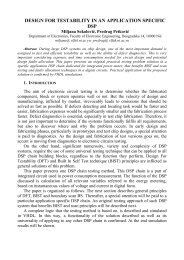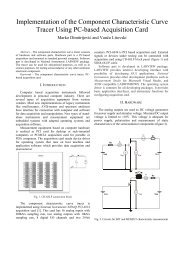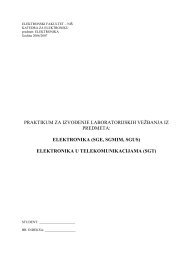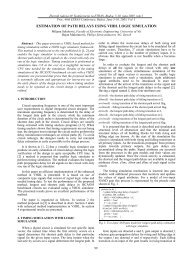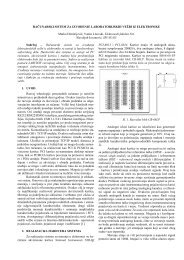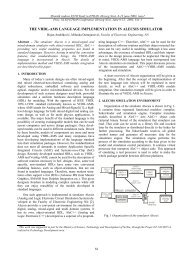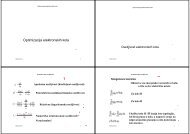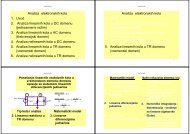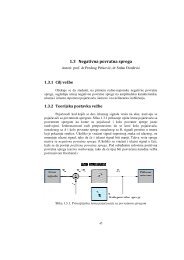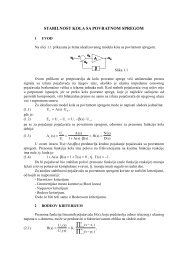6. Digital simulation in Alecsis - LEDA
6. Digital simulation in Alecsis - LEDA
6. Digital simulation in Alecsis - LEDA
Create successful ePaper yourself
Turn your PDF publications into a flip-book with our unique Google optimized e-Paper software.
94 <strong>Alecsis</strong> 2.3 - User’s manualThis type of arrangement of future events agrees with the behaviour of real digital components. The eventcaused by a short-lived impulse will be erased <strong>in</strong> the case if <strong>in</strong>ertial delay before its time comes, so the componentthat owns the driver will not react to the impulse.Simulator constantly controls the time of the first event on the list of every driver. If the time agrees with thepresent moment, the value of that event becomes the new value of the driver. In order for the new value of driver tobecome the new value of the signal, at least one of the two conditions needs to be met:• Signal has only one driver;• Signal has an appended resolution function, which will resolve the f<strong>in</strong>al value fromdriver values.<strong>6.</strong>2.5.3. Resolution of conflicts on the bus (resolution function)A signal with two drivers gives rise to wired logic. We can approximate a number of outputs of digitalcircuits us<strong>in</strong>g voltage sources with their output resistances. By superimpos<strong>in</strong>g these sources, we can arrive at theresult<strong>in</strong>g value at a node. If the output resistances differ significantly, the result<strong>in</strong>g value <strong>in</strong> a node is the result ofthe source with the smallest output resistance. Speak<strong>in</strong>g <strong>in</strong> wired-logic terms, signals can, beside the state, have<strong>in</strong>tensity. The follow<strong>in</strong>g conditions need to be met if the simulator is to model wired logic:• System of states has to have a state of high impedance, <strong>in</strong>dicat<strong>in</strong>g that the driver iscurrently off-l<strong>in</strong>e;• Every multiple-driver signal has to have a resolution function.typedef enum { 'x', '0', '1', 'z' } four_t;four_t bus4res (const four_t *drv, <strong>in</strong>t *report) {<strong>in</strong>t ndrivers = lengthof drv;four_t result = drv[0];for (<strong>in</strong>t i=1; i 1 && result == 'x') *report = 1;return result;}signal four_t:bus4res bus[3:0];signal four_t:bus4res l<strong>in</strong>e = '0';Function bus4res given above makes the resolution for the system of four states. If at least only onedriver is 'x' (undef<strong>in</strong>ed), the result is also 'x'. If none of the drivers is 'x', but there are at least two of themhav<strong>in</strong>g different logic values '0' and '1', the result is aga<strong>in</strong> 'x', as there are two drivers with different valuesand high <strong>in</strong>tensity. The wired logic is normally used when only one driver drives the bus, which means that allothers are at high impedance state 'z', that is, have weak <strong>in</strong>tensity.



